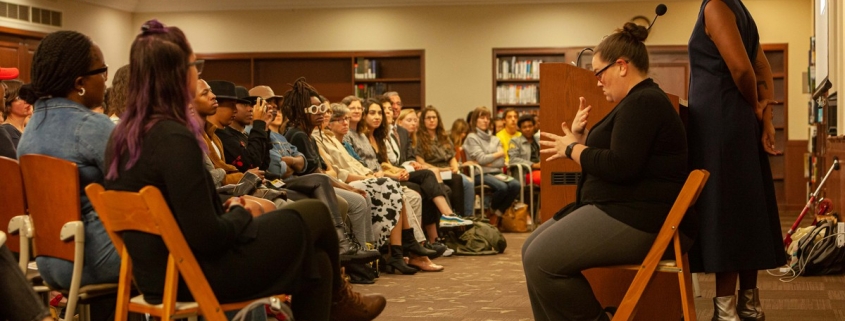Visions and Voices shines a light on representation in art

Writer, curator, influencer and activist Kimberly Drew discussed the importance of Black artists’ representation in the museum world at her Visions and Voices talk on contemporary art and activism Tuesday night.
In 2015, Drew was hired by the Metropolitan Museum of Art in New York City as the associate online community producer, before taking on the role of social media manager. She is an advocate for equity, representation and accessibility.
Drew entered the art scene as an intern at The Studio Museum in Harlem while attending Smith College, where she discovered a poster of artist Jean-Michel Basquiat. On a quest to find more Black artists, Drew said she viewed many of the contemporary artists she encountered as Black versions of the white artists traditionally taught at her university. At the time, Basquiat struck her as “the Black Andy Warhol.”
“I tell that story because … it’s kind of ridiculous that we have to think about there being the Black version of anything,” she said.
After her internship, Drew returned to Smith College and added an art history major (with a museum studies concentration) to her bachelor’s degree in African American studies. Unsatisfied with the lack of diversity of artists discussed in her classes, she struggled to find resources online for Black contemporary art.
So in 2011, she decided to make her own — a Tumblr blog appropriately called “Black Contemporary Art.”
“In the same way that I had encountered that image of Warhol and Basquiat, casually, I didn’t want anyone to have to climb over mountains to learn about Black artists,” Drew said.
After graduating, Drew landed jobs at nonprofits, literary magazines and art galleries such as Creative Time, Hyperallergic, The Studio Museum and Lehmann Maupin. It was during this time when she began using Instagram as a platform to invite her community to participate in the museum world.
“I would visit as many art spaces as I could, do my best to report back and try to show people literally different choreographies of how to engage with art,” Drew said. “[I’d] try to make sure that people knew there were Black artists that were showing downtown … and that you could look like me and be in a gallery.”
By the time she reached the Met, social media had become an opportunity for her to better illustrate the world of art she loved to those who were marginalized by it.
“What does it mean that this institution that holds 5,000 years of art feels so inaccessible to so many?” Drew said.
During her three-year tenure at the Met, Drew grew the museum’s audience by nearly 6 million followers.
Currently, Drew is lecturing, writing and shining light on underrepresented artists. She has two books set to be released in 2020: “Black Futures,” a visual anthology jointly edited by her and The New York Times culture writer Jenna Wortham, and “This Is What I Know About Art,” a young adult novel.
“I wanted to make this book so that young people [understand] that they can be a part of the art world,” Drew said.
Despite her success, Drew admits she’s still figuring life out but did not leave the seniors without a word of advice.
“I really think it’s important for any of the students … to understand that there’s so much future and to seize the moments that we have while we have them,” Drew said.
The event was organized by seniors Jabrea Patterson-West, who is majoring in French and art history, and Julienne Dawidoff, who is majoring in art history. During her freshman year, Dawidoff reached out to Drew through email and was pleasantly surprised when she responded with a recommended list of books.
“Kimberly Drew has been an inspiration of mine for a long time,” Dawidoff said. “I thought that was the most amazing thing.”
Both Dawidoff and Patterson-West spent over a year actively planning the event. Like Drew, both students want to raise awareness about representation and accessibility in art.
“[Underrepresented artists] need to be foregrounded,” Patterson-West said. “Very often they’re an afterthought.”
Dawidoff said that, as a senior, it was reassuring to hear Drew admit she didn’t have all the answers to her career after graduation.
“[That] version of me had no idea what was next,” Drew said. “I stand here today because of that person’s courage.”

